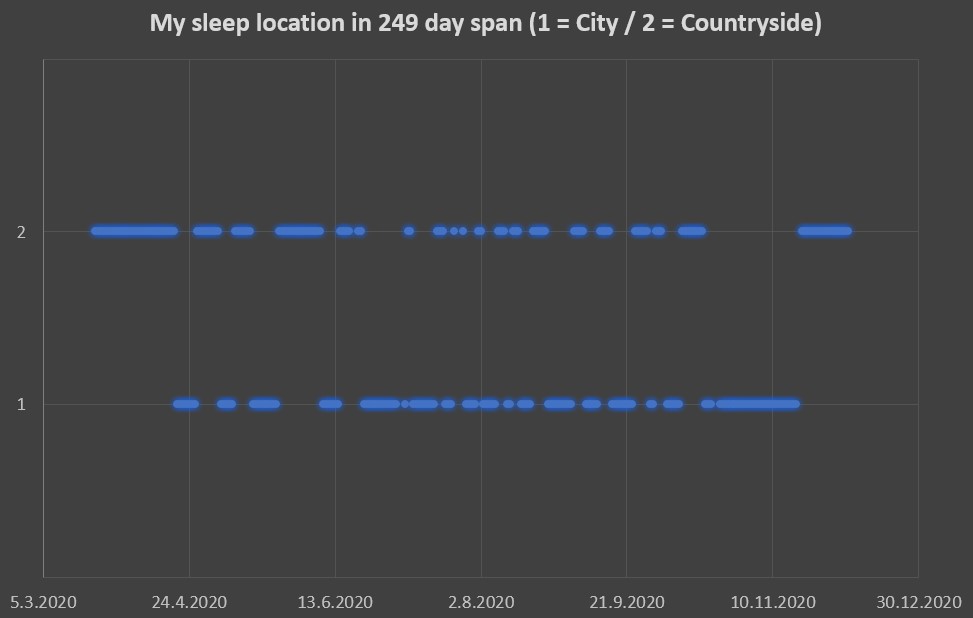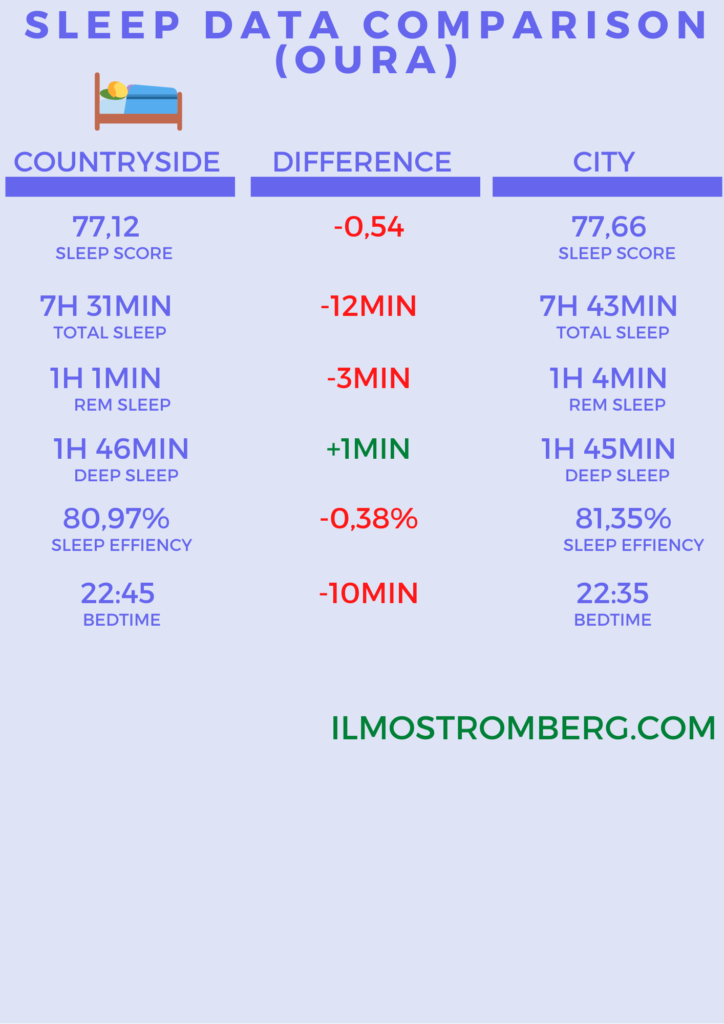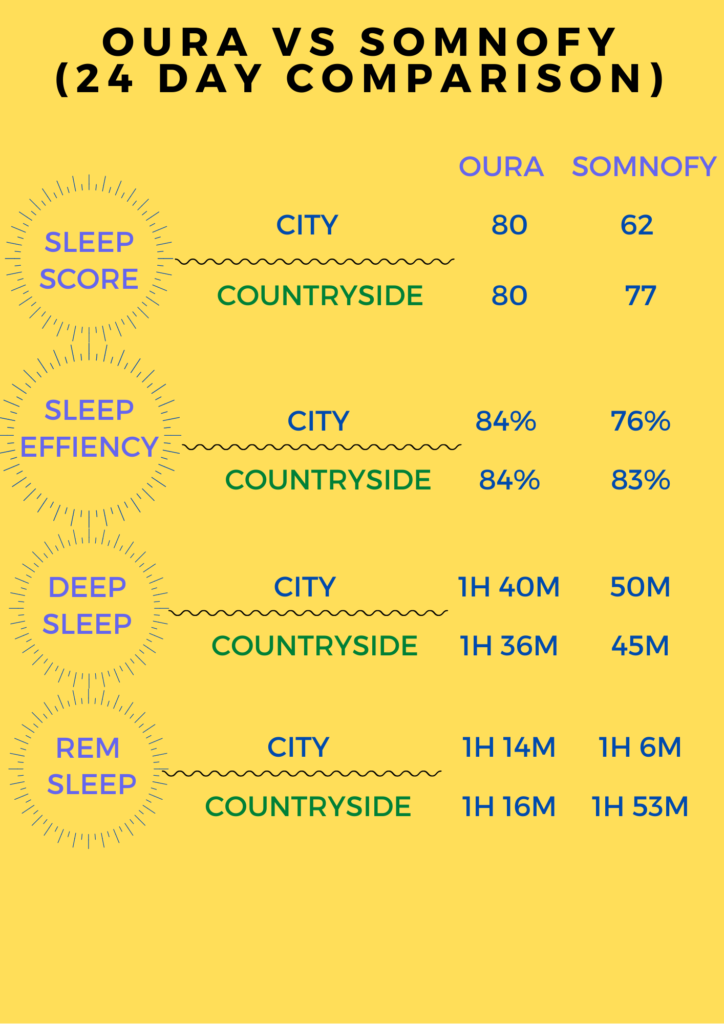Last year I spent 125 nights in the countryside. That got me thinking; How do I sleep in the countryside compared to the city?
I feel like my sleep quality is better in the countryside, but is it so? And why do I think like that?
Before we search for answers to these questions, let’s look at scientific studies on this topic.
What does science say?
Just thinking with common sense, it should be obvious that sleeping in the countryside should be better.
That said, there are studies about rural communities that sleep poorer than the average citizens in Europe or U.S [1]. The countryside itself isn’t a guarantee for good sleep.
What if we flip around the question: Are there proven elements in the city that disrupt our sleep?
Road traffic noise is now considered harmful pollution, and it can cause serious sleep disturbances [2].
One very interesting study interviewed over 15 000 participants over an eight-year period about their sleep habits and quality of sleep. This was combined with the data from a satellite that looked at how much outdoor light those people were exposed to at night. Both cities (over 500 000 people) and small towns and rural areas were inspected in the study. [3]
People with high light exposure during the night had a 13 % less satisfaction rate on their sleep quality.
One study investigated two different communities in Argentina. They share the same ethnic and sociocultural background. The difference was electricity. Only one community had access to that. The study concluded that access to electric light is associated with shorter sleep duration [4].
Matthew Walker, in his excellent book “Why We Sleep,” also discusses the problems with artificial lights. Even your bedside lamp can suppress your melatonin release, meaning that it’s harder to fall asleep. A bedside lamp isn’t the only enemy; according to a survey, 90% percent of individuals used electronic devices one hour or less before bed. Not only will it increase sleep onset time, but it will also decrease REM-sleep time.
It seems like artificial light and noise are the biggest factors in the cities that disrupt our sleep. Now, let’s deep dive into my life.
City versus countryside sleep comparison in my life
I’m living in 2 different locations – A neighborhood next to the Helsinki city center (10-minute walk) and in the countryside that is 100 kilometers from Helsinki.
Following things makes sleep experience better in the countryside for me:
The bed is bigger and better (correct softness)
The bedroom is more chill
When night comes, you cannot see anything in the bedroom as it gets completely dark.
There are no outside noises (like neighbors, police sirens, etc.)
2. If that is true, how can I make my sleep experience in the city more "Countryside" like?
Deep dive into the sleep data
As I spent 125 nights in the countryside last year, I will add another 125 nights in the city to make analyze comparable.
Thanks to Google location sharing and timeline feature, I can easily see my location history even with one-minute accuracy.

In the spring I spent clearly more time in the countryside. In the summertime, the city was my main sleeping location. Early / Mid Autumn was pretty evenly distributed. There can be some seasonal differences in my sleep, but we should be able to make conclusions from this data.
So, what does Oura say?

I wasn’t expecting this at all, Countryside had 1 minute of a more deep sleep, but in other metrics, it lost.
Oura’s accuracy in sleep measurements is another topic itself; everybody that’s deep in the topic knows that it’s not close to the gold standard of sleep evaluation, polysomnography (PSG). Still, I’m baffled about the results.
Luckily, I don’t have to settle just with Oura. In November 2020, I started to use Somnofy, a Norwegian-made non-contact sleep monitor. I listed it as one of the most interesting health gadgets in 2021.
Unfortunately, we can only compare 24 days of data, as I haven’t been in the countryside since early December. The analysis is still interesting as Somnofy also counts air quality, temperature, ambient lux, and sound level. Factors that are very relevant in the city versus countryside comparison.

With Somnofy and smaller sample size, we can see a clear difference between countryside and city sleep metrics, and it supports my hypothesis. We can also see that temperature, air quality, and sound level were all the better in the countryside. For sound level, I have to mention that I’m using raindrop sound from Ipad to block outside noises in both locations (not necessary in countryside but I’m use to it). In the city, Ipad is closer to Somnofy, so we have to consider that. There were no differences in ambient lux values (not sure why Somnofy didn’t pick that up in the city).
Now, as Oura and Somnofy are giving different messages, which one should we trust? In a sense, this blog post took an unexpected turn. If Oura doesn’t recognize difference in the same 24 day period, it feels like Somnofy is a superior device for sleep measurements.
Let’s compare Oura and Somnofy results in the 24 day period:

Oura pretty much gave the same result in the city and countryside, but with Somnofy there was a clear difference. Somnofy was aligned with the subjective feeling I had about sleeping in the countryside versus the city. In the future, I will give more attention to Somnofy metrics.
How to improve sleeping experience in city?
There are 2 main issues when sleeping in the city; Noise and lights.
I’m using Ipad with raindrop sounds to block outside noises, it does help, but it doesn’t block everything like roadwork sounds. This isn’t a problem every night, but sometimes it can wake me up earlier than I wanted. There are 3 popular ways to solve this problem:
1. Earplugs
2. White noise machine (probably better than my Ipad with raindrops)
3. Sleep headphones
I’m going to do research about this for the best option and try that in the future.
Lights can be divided into two categories: lights that come from the room and outside lights. There’s limited space in the city apartment, so I have electronics in the bedroom, not an optimal situation. There are also few extension cords with lights, I haven’t paid attention to them before, but obviously, it’s not ideal for keeping them on at night. If electric light cannot be shut down during the night, a good option is to use light dim stickers to block the light.
To block outside light, a bedroom curtain is a must. The problem is that it’s hard to block it completely. The sleep mask is one option for this problem. I will definitely also research this option.
Key takeaways
It was surprising to find out that Oura didn’t think that countryside was better for my sleep. Here we come to a fundamental question; how much emphasis should we put on for sleep gadget results? In the end, Oura has always been a recovery monitoring tool for me, not for sleep.
Somnofy seemed to be more accurate; however, the comparison period was only 24 days. I will analyze it more when I get back to the countryside. Even with Somnofy, I don’t really pay attention to REM or deep sleep lengths as it’s tough to know which gadget gets it right without proper scientific studies.
I will continue to optimize my sleep in the city. For future writings, I’m planning to do a 60-day ultimate sleep improvement experiment. Stay tuned and subscribe!

